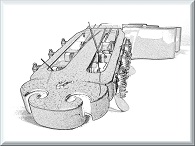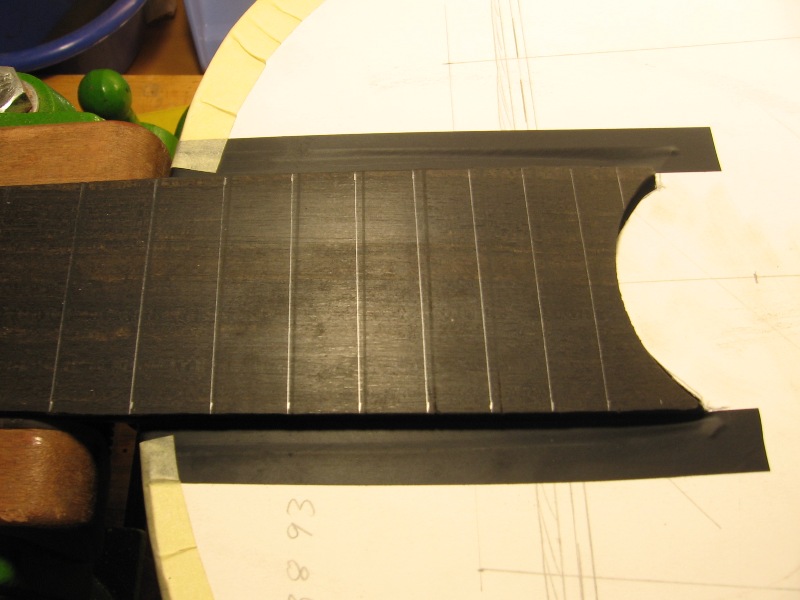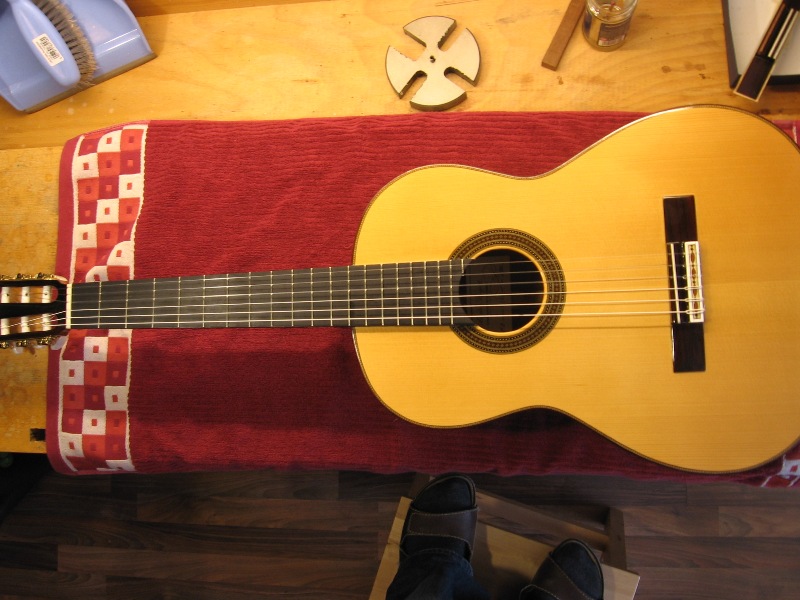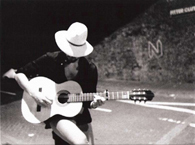Welcome to one of the most active flamenco sites on the Internet. Guests can read most posts but if you want to participate click here to register.
This site is dedicated to the memory of Paco de Lucía, Ron Mitchell, Guy Williams, Linda Elvira, Philip John Lee, Craig Eros, Ben Woods, David Serva and Tom Blackshear who went ahead of us.
We receive 12,200 visitors a month from 200 countries and 1.7 million page impressions a year. To advertise on this site please contact us.
|

|
|
RE: Eventual end of guitars structural intonation issue
|
You are logged in as Guest
|
|
Users viewing this topic: none
|
|
Login  | |
|

   
MunichLuthier
Posts: 18
Joined: May 12 2015

|
 RE: Eventual end of guitars structur... (in reply to Ruphus) RE: Eventual end of guitars structur... (in reply to Ruphus)
|
|
|
Hi all!
Wow, lots of emotions here and arguing besides the topic.... anyhow, I'll try to help and clarify. Befor I do, I want to make clear what I use what words for:
Temperament is the system we tune fixed instruments such as pianos, guitars, ... all instruments, where the player does not freely set the frequency of a tone. The tempered tuning came up as far as I know around 1700 with organs and the first hammer pianos and its the reason why Bach wrote the "well tempered piano" in order to demonstrate to the public that the tempered tuning allows to play in all keys. As a guitar is a fixed tuned instrument (we can not move the frets while we play) it is tuned in a tempered tuning in order to be able to play it in all keys. The other tuning system is a "pure tuning" (I am no native speaker) where the tones are tuned according to the key you play in. So an As can be different to a Gis in this system - for us, its the same fret and this is one of the reasons why violinists smile at us...
Compensation has nothing to do with temperament, its just a correction that luthiers apply to a guitar as while we play, we increase the tension of a string and its length by pressing it down between two frets (the more we press, the worse ;-)). In oder to correct the intonation of aguitar, luthiers move the bridge between 1 and 3 mm (on a classic guitar) so that the scale gets longer. They usually do this with balancing the flageolett and pressed tone on the 12th fret. The compensation is different on all luthiers, on all kinds of construction, ...
Intonation is how close a guitar and a players gets the frequency of each tone to the frequency it should have (according to tempered tuning if you want). So a good intonation is close to the target, a poor one is wrong and one can hear that.
A violin player is only bussy with intonation as they have total freedom to set the frequency of each tone by the position they press and the vibrato thing you discussed (the rolling) is meant to vary the tone, which makes sense as the rolling varies the point where the string is pressed. Rolling on a guitar makes no sense, as the string always just starts swinging after the fret it lies on, but with rolling the player also changes the force of his finger up/downwards and thus creates the same effect, but he is doing that with changing the tension and not the position. ...I play cello for some years now, so I know what I speak about.
So, sorry about that, you find all of the above on wikipedia and I am sure you know, but just to avoid that we missunderstand the words.
What is my patent and why?
I make guitars for 15 years now and as I started (autodidactively) I used my skills as a studied physician to think about the intonation issue, that I always faced on my guitars, as I am playing for 40 years now and I have a kind of perfect pitch and always suffered... I invest more than 200 hours of work in building a guitar and some 800 Euros in wood and material so why not investing some energy in a better intonation?
Today, most guitars are made by CNC machines that are sawing the fret nuts based on a mathematic calculation. In earlier days (Torres, Ramirez, Hauser, Hermanos, name them ...) they determined the fret positions by listening and comparing to a violin or a piano and then they made a template for that and did not only rely on a calculation. This is the reason, why some of the old makers have an incredible well intonation. I listened to a concert with La Leona several times, I own a Hauser myself and have repaired another one and all were perfect in pitch. But the empiric times have gone and as most factories use CNC saws, the problem starts.
What I did is close to what constructordeguitarras wrote: I decided not to compensate the brigde by comparing the 12th fret with flageolett (which btw. makes that table useless that El Kiko posted, because alomost all guitars are fine at the open string and at the 12th exactly because of this method!) but I decided to move each fret away from its calculated position in order to compensate each one individually. The assumption was that the error gets bigger, the shorter the remaining string length is and thus the first fret gets almost no compensation and the 19th gets a lot.
So now we have a tiny thin 1st string and a big fat 6th string and of course, you need different compensations for both of them. So if used to its full extend, my patent provides non parallel frets that "twists" the more, the closer you get to the 19th or 20th fret. And I also made a variation, where luthiers can only use the compensation that I calculate for the 1st string and as the 6th needs more, they slightly twist the bridge. So in this application, my patent combines new and old way of compensation. This variation is made, because I wanted my patent to be applicable also for those luthiers, who use a CNC saw, as they can only saw parallel nuts.
What is the result of my patent or intonation impovement? Guitars that use this system do not only intonate correctly at the 1-3rd fret and around the 12th but also where the real problems are around frets no. 6-10 and 14 and above. If one saws by hand and makes non-parallel frets, the results are fantastic, on parallel they are at least better than in conventional fingerboards.
What are the limits? I still do not calculate each position individually because almost no guitar maker is able to build that. My goal was to produce something everyone can use without totally changing manufacturing equipement. So my improvement also has some issues where intonation is not perfect. If you look at the fretmobile from Chouard it is a great solution, but is it practical? What happens, of you bend the string and flip over the end of each piece of fret...? And yes, when a string is out of tune, the entire guitar is out too - I am working on inventing a miracle but hey that's damn hard... ;-)
And yes, some guitars don't need my system, as e.g. on flamenco you have a very low acting hight and the increase in tension and length is not producing audible faults. And other guitars are fretted by an old or just good template. But one can say that if everyone uses my patent, there would be hardly any more poor intonating guitars.
What I do when correcting the intonation on an existing guitar, I always try to make that as smooth as possible for the guitar. So in many applications, I get very good results by using Konrad Schwingensteins method that is known as buzz feiten in the US (actually, they stole his patent, because its only protecting him in Germany). I use it because it avoids a new fretting of the guitar which is a heavy work that has a lot of impact. But on some guitars, the miss-match of the frets is so heavy, that only new frets according to my system do the job.
Whether you want to use my system or not is up to you - I don't force anybody. I did invest some three years of research for an existing method but there is none and for fine tuning my calculation method. I built 4 guitars in order to test it and changed fretboards on them partly three times - so I did a lot of work and it costed a lot of money. So I patented it in order to protect my intellectual property. The meaning (and the legal precondition!) of a patent is to produce an exact description of what you do in order to allow everybody to do the same BUT everyone knows, that there is an inventor and he must be compensated for his work. I give it for free to everyone who wants to try or who builds guitar as a hobby and I charge a fee of 20,- EUR per fingerboard for everyone who uses it commercially. RNJ you can get it all at the patent office or just write me an email over my website.
So, thats more or less all I can add. Questions are welcome, doubts too, missunderstandings are appreciated and will be clarified but insults will be ignored ;-)
Cheers to all of you!
Michael
_____________________________
http://www.ruhe-gitarren.de
Music is the language of all human beeings
|
|
|
|
REPORT THIS POST AS INAPPROPRIATE |
Date May 15 2015 17:00:35
 |
|

   
Ricardo
Posts: 14797
Joined: Dec. 14 2004
From: Washington DC

|
 RE: Eventual end of guitars structur... (in reply to MunichLuthier) RE: Eventual end of guitars structur... (in reply to MunichLuthier)
|
|
|
quote:
And yes, some guitars don't need my system, as e.g. on flamenco you have a very low acting hight and the increase in tension and length is not producing audible faults.
ok great..so we can carry on as usual. 
Seriously...incase you didn't read it...both Rupus and I, opposite sides of a fence somehow, agree that in your examples, the cedar top is intonating BETTER than the spruce top (villa lobos clip vs albeniz respectively). Any thoughts? Ruphus has since come to conclusion the culprit is the B STRING TUNING being off (after his initial assumption that the player was at fault due to the particular passage, non of which are revealed in the cedar example). I was curious if there might be ANY other differences we don't know about between the two builds (degrees of compensation, action height, scale length, string brand, etc) that could be a contributing factor. If not, whether or not you have an opinion on this?
thanks for your time.
Ricardo
_____________________________
CD's and transcriptions available here:
www.ricardomarlow.com
|
|
|
|
REPORT THIS POST AS INAPPROPRIATE |
Date May 17 2015 19:07:27
 |
|

   
MunichLuthier
Posts: 18
Joined: May 12 2015

|
 RE: Eventual end of guitars structur... (in reply to Ricardo) RE: Eventual end of guitars structur... (in reply to Ricardo)
|
|
|
Hi Ricardo,
sure, just go on! ;-)
...but just in case that you sometimes fight with intonation, even a pistola can be improved with a small correction.
The sound samples were played by a name-brother of yours: Ricardo Havenstein. The difference between the two is in fact that the spruce wasen't perfectly tuned. Ricardo was on a rush at those days and we had no time to repeat the recording and now he lives back in his home in Argentina and I have to wait for another prfessional guitarist to do me the favour to record something for me.
I have corrected approx. 50 guitars in the past 5 years and the observation is kind of surprising: Not even two guitars showed the same problems, they all had problems independent on the string material and manufacturer. And also some of my guitars have intonation issues and need additional fine tuning. The reason is simple: wood is no homogenuous material, it varies in density, in weight, in flexibility and thus it produces variances. I have messured all 50 guitars and even if they were perfect mm-wise they sometimes had severe intontation issues. My last two guitars I built (one spruce, one cedar) were the same to the 10th of a mm but anyhow, I had to finetune the cedar whilst the spruce was perfect in intonation.
But before you now come to the wrong conclusion "well, then nobody needs your system" I have to say that all guitars that I either built or corrcted were by far better in intonation as the ones that were built according to the standards. But for me, there is no "fence" because any player is free to decide and I know some professional guitarrists that love their guitars and that have developped their playing so that they correct known issues while they play. So they strech or compress the strings in order to produce a correct pitch and they just don't want to re-learn.
I don't want to persuade anybody, but I know that with my system, the guitar would be easier (less efforts to correct intonation) and nicer (audience likes the music better) to play and guitar music would get more touch. ...as I speak of touch, there is one thing never discussed here: I made many tests with my guitars and everytime, we played them to an audience, they gave the feedback that the music played with my guitar would sound sweeter, nicer, "better tell the story of the piece". So there is something beyond what you will measure with your tuners: the feeling that music produces. Just yesterday a player from Vienna picked up his guitar and as he played it, he was overwhelmed because "it sounds much better than before" - the reason simply is that overtones and resonances develop much better.
Cheers!
Michael
|
|
|
|
REPORT THIS POST AS INAPPROPRIATE |
Date May 18 2015 10:38:15
 |
|

   
MunichLuthier
Posts: 18
Joined: May 12 2015

|
 RE: Eventual end of guitars structur... (in reply to Ruphus) RE: Eventual end of guitars structur... (in reply to Ruphus)
|
|
|
Hi again!
First to estebana: I think I explained quite well, how my patent works. If you want the exact formula, I can give it to you but you also can just search for my patent No. 10 2007 034 770.9 at the German and European patent office and you will get an in depth explanation.
I also explained it in words in an earlier post, where I described exactly what I do. It feels a bit sad to invest all the time and then find someone beeing sceptic but not using the information given.
Next to Jeff: The image has misslead you, it no more then 1,2 mm on the 6th string - you can't see that the front of theat piece of bone is filed as / and not as | so the actual shortening is less than the piece of bone. I do this to give it more stability. And may I ask how many guitars you have corrected because I have some 10 years experience now and I am gladly discussing but want to be sure that I discuss on a "knowing" and not "guessing" - don't get me wrong please, but I have to use my time carefully.
And to the obvious endless discussion of equal temperament and who is correcting what: I stay within the equal temperament, because we are all playing an instrument, where the tones are fixed by frets and not on a fretless instrument. I said this already. So as for some 350 or 400 years already, equal temperament is the only way to go and who discusses this should please first read the books. Sorry for sounding upset, but I have had so many discussions and so often it turned out that people did not have the basics. So if someone puts the equal temperament in question, please safe our time!
So as we are within the equal temperament, we all have the issue that it is good on some keys and bad on others - NO ONE can change that!
Saying that an intonation improvement is not neccessary, as equal temperament is an issue by itself may be acceptable, but guitars do not even fit the equal temperament in their pitch. And there is a lot of space for improvements on guitars to close the gaps that they have compared to this tonal system.
I do not accuse anybody and I have never said, that other luthiers don't do their jobs. But I have corrected guitars worth above 10.000 EUR with poor intonation - but you will never find the makers name in any of my reports! So I never blame others but yes, many could have done what I do now. But believe me: NO ONE DID! Do you know that the patent office checks for more then 6 months if there is any publiction or other invention before they file yours?! So estebana, you are wrong if you say that others have done the same previously!
So, now I go into my workshop again! All of you have a nice evening and pls forgive, if I sounded a bit upset!
Cheers - Michael
|
|
|
|
REPORT THIS POST AS INAPPROPRIATE |
Date May 19 2015 16:11:36
 |
|
 New Messages New Messages |
 No New Messages No New Messages |
 Hot Topic w/ New Messages Hot Topic w/ New Messages |
 Hot Topic w/o New Messages Hot Topic w/o New Messages |
 Locked w/ New Messages Locked w/ New Messages |
 Locked w/o New Messages Locked w/o New Messages |
|
 Post New Thread
Post New Thread
 Reply to Message
Reply to Message
 Post New Poll
Post New Poll
 Submit Vote
Submit Vote
 Delete My Own Post
Delete My Own Post
 Delete My Own Thread
Delete My Own Thread
 Rate Posts
Rate Posts
|
|
|
Forum Software powered by ASP Playground Advanced Edition 2.0.5
Copyright © 2000 - 2003 ASPPlayground.NET |
0.125 secs.
|


 Printable Version
Printable Version
















 New Messages
New Messages No New Messages
No New Messages Hot Topic w/ New Messages
Hot Topic w/ New Messages Hot Topic w/o New Messages
Hot Topic w/o New Messages Locked w/ New Messages
Locked w/ New Messages Locked w/o New Messages
Locked w/o New Messages Post New Thread
Post New Thread